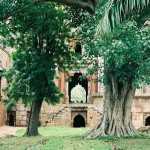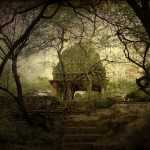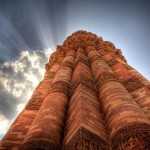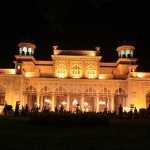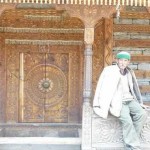Opening a blurry eye, I saw a blurry book in the hands of a blurry mother. Twenty plus score years of caring Shravan Kumar son-hood warned me that she was in her most enthusiastic avatar, and it would be wise if my sleepy self should just pretend to be in a coma. The act lasted, only till she poked that heavy William Dalrymple manuscript in my sides, making me splutter. If visualized, my reaction was just like Saurav Ganguly’s when the fast bowlers bowled one into his ribs – awkward and jumpy.
“Get up! I don’t want to reach late,” the molester whined. I wanted to tell her that Chandni Chowk was not going to run away, it had been standing right where it was for the last two centuries, but I am a good son. Also, she looked a little like Goddess Durga with that trishul, I mean book, raised high in her hands.
Half an hour later, we were in Delhi’s swanky metro, she beaming at everyone from her seat in the ladies’ coach, and me glaring at the wall as one more man stepped on my feet. When we got down from the metro, the crowd helped us reach the exit faster with their helpful shoves and pushes. In chaos, lies India’s comfort.
When we were out of the small alley that connected main Chandni Chowk to the station, we manned the long road like a sailor would the sea. “Ballimaran?” a shopkeeper said when we precisely asked him the same. “Keep going straight and turn left at the third red light. You’ll see the jooti market immediately.”
And just like he said, the shoe market of Ballimaran was right there,at the third left. Tens of shops with their colourful jootis, sandals, slippers dazzled our senses. A paints company’s catalogue itself could not do a better job presenting shades and colours.
But our quest was not footwear, it was Mirza Ghalib. Among other things.
The greatest Urdu poet the world has ever known, Mirza Asadullah Khan Ghalib lived in his residence in Gali Qasim Jaan, Ballimaran, Chandni Chowk for the last nine years of his life. In the words of eminent litterateur Ralph Russell, “Had Ghalib written in English, he would have been the greatest poet of all times, amongst all languages.” Arguable surely, but an indicator of how great the man was. Yet, how many people know he lived there. We might be living in the times of the internet, the times of social network, the times of communication at its best, we have been to Chandni Chowk so many times, and yet the house of one of the greatest poets lies unnoticed and unloved.
A modest museum, the house has a small bust of Ghalib, two of his preserved books, an old shatranj (chess) board and insensitively, an Airtel PCO. The walls are decorated with his quotes, and one wall has a fantastic life-size painting of him smoking a hookah.
“One of my dreams has come true today,” mum declared when we came out of the house. I guess I now know where my filmy streak stems from.
“Right, next we head for Saint Stephen’s Church,” she said referring to the notes she took from her Dalrymple. I flagged down a cycle rickshaw, and as the man weaved us in and out of the crawling traffic, the sweat shone on his muscled legs. Yet, he sang, to the street perhaps, and whistled at his comrades as we covered one metre after another, and only then could I realize the breeze that touched my face.
Also known as Fatehpuri Church, the red edifice of St. Stephen’s Church was built in 1867 and is the only church in the city where service is conducted in Urdu. It stands as a memorial to the British soldiers that died during the famous first mutiny for Indian independence. A diamond shaped signboard outside the building read “Number 29, Heritage Building”.
We then backtracked our way to Fatehpuri Mosque. On our way, we crossed Number 27 – “Dharamshala Rai Sahib Lala Laxmi Narayan”. In the midst of all the shops, it is easy to miss these heritage buildings even with their signboards, and we weren’t surprised when the shopkeepers had no clue about them when we asked. I tried to photograph the Dharamshala but the entangled low-hanging, teeming electric lines running across the street would not help my cause.
The mosque was, just as all mosques, emanating a sense of peace. It stood at one end of the Chandni Chowk street, directly opposite and rivalling the building at the other end - the Red Fort. When we went inside, it was as if we had entered another world, another era. One that moved at its own pace, unhurried, unfettered. Men sat in circles, talking and smiling. A Maulvi read from his book in a small room full of cushions, the ceiling fan clucking noisily. I did not do much, except for clicking photographs, but a sense of rest swept through me as I came out. While looking back to take a parting photograph of the building, I saw the clock at the top. It had no second or minute hands on it. Fitting, I think, for time really stands still in these parts.
Six hours from when we had started out, we were back in the metro. I scanned through the photographs, at the jooti market, at Parathe Wali Gali where we had had our lunch, and the famous terrace in the Gadodia Spice Market from where you can see all of Chandni Chowk, the Red Fort and the Jama Masjid.
Through the crowd of men, I tried to look at mum, sitting in the nearby ladies compartment. Catching my eye, she waved out exuberantly. Twenty plus score years of caring Shravan Kumar son-hood warned me that she was in her most enthusiastic avatar, and it would be wise if my sleepy self should just pretend to be in a coma…
———————————————————————




